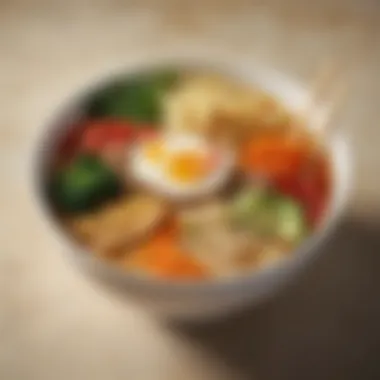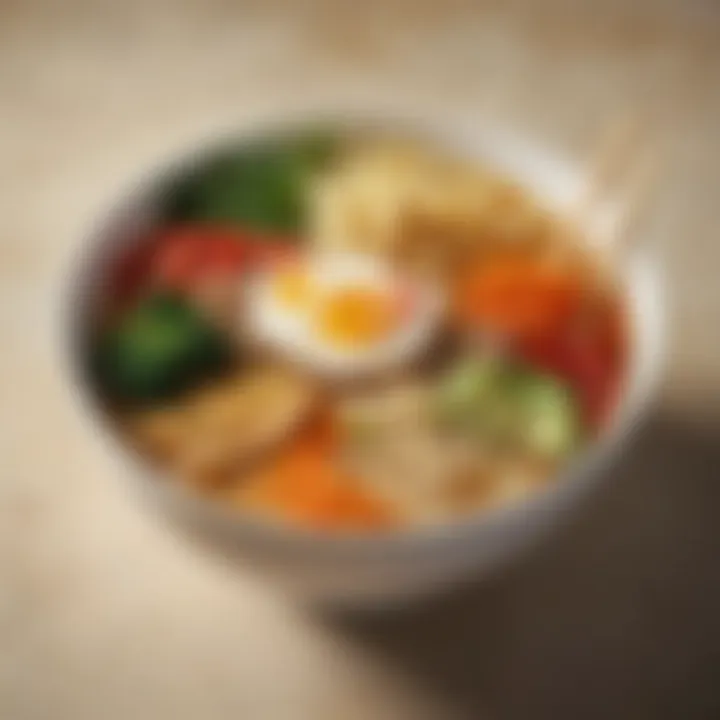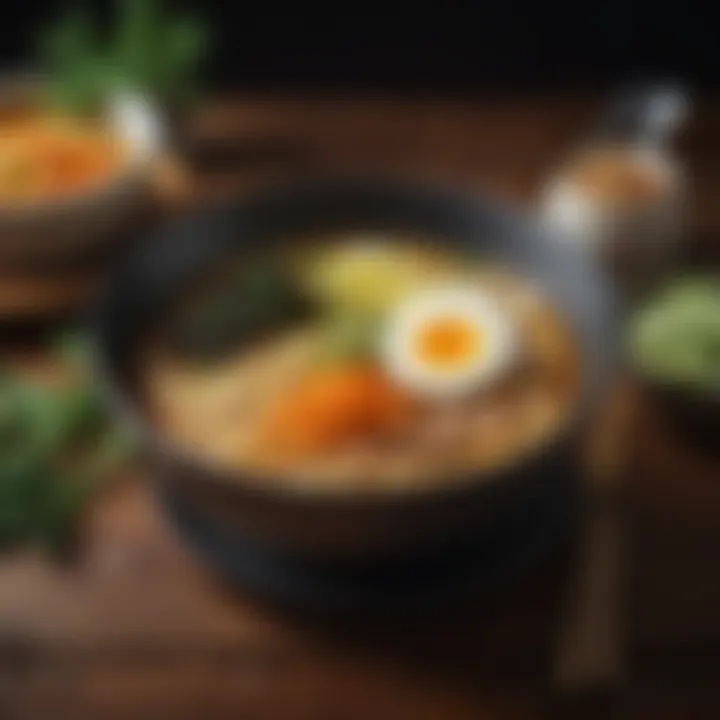Delving into the World of Vegetarian Ramen


Intro
Vegetarian ramen has gained traction in recent years, weaving itself into the fabric of culinary trends globally. But, how does this steaming bowl of goodness fit into our collective food narrative? At its heart, ramen is more than just a dish; it’s a testament to culinary creativity and adaptability. Historically rooted in tradition, vegetarian ramen serves as a canvas, exhibiting flavors from various cuisines while also catering to dietary preferences. More than a mere meal, it embodies cultural significance, highlighting a shift in dietary choices towards plant-based eating.
As we embark on this exploration, we aim to unpack the multi-layered essence of vegetarian ramen; its history, vibrant ingredients, and preparation methods which reflect the rich tapestry of global food culture. Whether you’re a food enthusiast or someone looking to expand their palate toward healthier options, this guide will shine a light on the lush realms of vegetarian ramen, revealing why it’s becoming a staple on plates around the world.
"Vegetarian ramen, unlike its traditional counterpart, embraces the notion of inclusivity, inviting all to savor its varying flavors and textures, while honoring the roots of Japanese cuisine."
Join us as we delve deeper into this fascinating dish and uncover its potential to leave a lasting mark on the culinary landscape.
Prelims to Vegetarian Ramen
Vegetarian ramen is a dish that stands as a testament to culinary creativity, allowing for a diverse range of flavors and textures while being mindful of dietary choices. This vibrant bowl of goodness isn't just a meal, it's an experience that resonates with both traditional and modern palates. As the plant-based movement catches steam, the significance of vegetarian ramen grows, drawing the attention of food lovers who appreciate both health-conscious eating and delightful flavors.
What makes vegetarian ramen so essential? First of all, it combines nutrition with taste in a way that's satisfying. The myriad choices of ingredients allow for customization, appealing to both seasoned chefs and novices alike. Moreover, restaurants and home cooks alike are discovering how to substitute traditional elements with plant-based options without sacrificing the soul of the dish. Not only does it democratize gourmet cooking, but it also opens up avenues for experimentation.
As we dive into the heart of this subject, it’s vital to consider how vegetarian ramen bridges cultures and experiences. It invites diners to explore flavors often hidden in meat-based versions, while reflecting on the broader nutritional and ecological implications of our food choices. From bold broths to an assortment of toppings, the journey into vegetarian ramen reveals a rich tapestry of flavors, culinary techniques, and cross-cultural influences.
Defining Vegetarian Ramen
Vegetarian ramen, at its core, is a noodle soup that excludes meat or seafood. Unlike its traditional counterparts, which often rely on rich pork or chicken broths, vegetarian ramen can utilize a plethora of vegetable stocks. This adaptability allows for endless interpretations, each filled with distinct, sumptuous flavors.
With broths crafted from ingredients such as mushrooms, seaweed, and miso, the resulting taste profile is often deeper and more complex than one might expect. This dish can include a variety of noodle types—wheat, rice, or even soba—and toppings that can range from simple green onions to intricate arrangements of grilled tofu or marinated vegetables.
Key elements of vegetarian ramen include:
- Broth: The lifeblood of the ramen, which is often prepared with umami-rich ingredients.
- Noodles: Different textures can elevate the dish, with choices like thick, chewy ramen or lighter rice noodles.
- Toppings: From traditional elements like narutomaki (fish cake) adapted to vegan versions, to creative flair through seasonal vegetables, the options are endless.
This definition expands the scope of what ramen can be, embracing inclusivity in dietary options while simultaneously preserving the cultural essence of the dish.
Historical Context of Ramen
Understanding the hills and valleys of ramen’s history sheds light on its evolution into vegetarian forms. Ramen first hit the culinary scene in Japan during the late 19th century, believed to have originated from Chinese noodle dishes. Initially, it was a food for the lower class before gaining momentum and being embraced by the broader culture in the early 20th century.
In the post-war period, ramen became a comfort food due to its affordability and the rise of instant ramen dishes. With the global rise in vegetarianism during the late 20th century, the notion of vegetarian ramen began to take root. Chefs were compelled to rethink this beloved dish, carving out a niche that catered to the health-conscious without compromising flavor or authenticity.
As food culture began to flourish worldwide, vegetarian ramen started to gain traction outside Japan. Major cities around the globe now boast vegan and vegetarian ramen bars, allowing for local variations that influence traditional methods.
"Ramen has transformed from a humble street food to an international sensation, reflecting a broader trend toward diverse dietary needs."
The journey of ramen is a reflection of changing social norms, and the vegetarian parallel demonstrates how food can adapt while retaining its core essence. As we continue to explore this dish further, we uncover its contemporary relevance and its promising future.
The Cultural Significance of Ramen
Ramen holds a cherished spot in the culinary landscape of Japan. Beyond the tempting flavors that swirl in a bowl, its role in society is multifaceted, intertwining tradition, community, and modernity. Ramen isn't simply food; it’s almost an emblem of comfort and connection, encapsulating the essence of everyday life in Japan.
Ramen in Japanese Society
At its core, ramen speaks to the heart of Japanese culture, capturing a unique blend of history and artistry. Traditionally, ramen was a dish enjoyed by the working class, a quick meal that filled hungry bellies. Over time, it transformed into something much deeper, reflecting regional diversity and local flavors. In fact, every region in Japan boasts its own distinct style of ramen, from the soy sauce-based Tokyo ramen to the rich, pork broth of Hakata.
Ramen shops serve as community hubs, fostering social exchanges mingled with the aroma of steaming broth. The casual atmosphere encourages connection among diners, whether they know each other or not. Think of it as a modern-day gathering place where stories are shared over a bowl of noodles.
"Ramen is more than sustenance; it's an experience that brings people together, bridging gaps in society and sparking conversations."
In Japan, the ritual of slurping noodles is not only acceptable but expected; it’s sign of enjoying the meal. This practice conveys appreciation for the chef’s craft and elevates ramen into a cultural performance of sorts. The dish symbolizes perseverance, evolving over centuries while adapting to contemporary tastes and lifestyles.
Vegetarian Ramen's Growing Popularity Worldwide
As the world becomes increasingly aware of health and sustainability issues, vegetarian ramen has begun to travel far beyond its birthplace. The global twist on this beloved dish is noteworthy. Consumers are making more conscious food choices, driving demand for plant-based options across various cuisines. Vegetarian ramen stands out as one of the winners in this movement, catering to both vegetarians and those occasionally reducing meat from their diet.
This culinary migration has seen enhancements crafted to suit regional palates—such as the spicy miso ramen favored in parts of North America and the inventive use of local vegetables and spices found in Europe or Australia.
Moreover, as more chefs experiment with creative broths and toppings, vegetarian ramen is carving out its niche, showcasing what can be achieved with vegetables, herbs, and spices. Each bowl tells a story—one of adaptation and innovation that resonates with a truly global audience.


From food trucks to upscale restaurants, vegetarian ramen is showcasing itself as an adaptable dish, encouraging even those who might usually opt for meat to explore a more plant-centric lifestyle. As the love for this meal spreads, it fosters appreciation for Japanese culture and emphasizes the importance of sustainable ingredients, placing vegetarian ramen at the intersection of tradition and modern dining practices.
Core Ingredients in Vegetarian Ramen
When diving into vegetarian ramen, understanding the core ingredients is pivotal. These elements shape the dish's flavor profile and nutritional value, making them essential for anyone who wants to master this culinary art. The harmonious blend of broth, noodles, and toppings creates a symphony of tastes and textures that intrigue the palate.
Selecting Broths: Options for Depth of Flavor
A well-crafted broth sets the stage for vegetarian ramen. It's like the canvas for a painting; without a good foundation, the final product can fall flat. Broths can range from light and delicate to rich and intense, depending on the ingredients used.
- Miso Broth: Rich in umami, miso adds a complex flavor that comforts the soul. Mixing shiro (white) miso with dashi made from konbu (seaweed) can result in a smooth, creamy consistency.
- Shoyu Broth: Soy sauce provides a salty kick, and its versatility allows it to act as a fantastic base. Adding sautéed garlic or ginger heightens its aromatic qualities.
- Vegetable Stock: Using fresh vegetables like onions, carrots, and celery creates a broth that’s light yet flavorful. Simmering slowly extracts all the goodness, leaving a vibrant base for your ramen.
- Coconut Milk: For an unconventional touch, coconut milk brings a creaminess and slight sweetness to the broth. This can work wonders when paired with spices like curry for a fusion twist.
Incorporating these broths requires attention and a willingness to experiment. The right combination can elevate your bowl to new heights.
Noodle Varieties: An Overview
Noodles are the backbone of ramen, and they come in many shapes and sizes. From thin and delicate to thick and chewy, noodle choice greatly affects your dining experience.
- Wheat Noodles: Most traditional ramen uses kansui, an alkaline mineral water, to create that distinctive chewy texture.
- Soba Noodles: Made from buckwheat, these offer a nutty flavor. They are slightly healthier, making them a great option for a lighter meal.
- Udon Noodles: Thick and often chewy, udon noodles present a hearty option. Ideal if you're looking for a more filling experience.
- Rice Noodles: Gluten-free and versatile, rice noodles can absorb flavors well, adding a different but enjoyable texture to your ramen.
Choosing the right noodle complements your broth and elevates the overall dish.
Toppings: Essential Elements of Flavor
Toppings may just seem like finishing touches, but they’re essential for transforming plain ramen into a work of art. They add freshness, color, and flavor, ensuring the dish is well-balanced.
- Green Onions: Sliced thinly, they offer a crunchy burst of flavor.
- Tofu: Whether fried or marinated, it provides protein and a satisfying texture.
- Mushrooms: Varieties like shiitake or enoki introduce umami depth.
- Nori: Seaweed sheets add a touch of oceanic saltiness, rounding out the flavor spectrum.
- Pickled Vegetables: Adding a touch of acidity, they cut through the richness of the broth.
- Chili Oil or Flakes: For those who like a bit of heat, these can transform your bowl into a spicy delight.
Selecting the right toppings is like composing a melody; each element plays a role in creating harmony.
There’s no one-size-fits-all guide when it comes to making vegetarian ramen. It's a culinary adventure, with core ingredients setting the foundation for creativity and experimentation. Choose wisely, and let your taste buds lead the way.
Preparation Techniques
Preparation techniques are the backbone of any great ramen. They transform simple ingredients into a complex, mouthwatering dish. The heart of vegetarian ramen lies not just in the ingredients, but in how they are treated and combined. Getting these techniques right ensures that you not only deliver flavor but also keep the integrity of plant-based cooking at the forefront.
Crafting the Perfect Broth
A broth is the soul of ramen; it’s where all the flavors meld together. In vegetarian ramen, the key here is to extract as much flavor as possible from fresh vegetables, spices, and umami-packed additions like kombu or shiitake mushrooms. Start with a base of aromatic vegetables like onions, garlic, and ginger—all sautéed until fragrant. After that, toss in hearty ingredients like carrots and celery for depth.
Simmering these ingredients in water, along with a good pinch of salt, cultivates a robust liquid. The volume of simmering time really depends on the desired intensity of flavor. A longer simmer typically yields a richer broth. Don’t shy from tasting as you go; this allows for adjustments and the creation of a personalized recipe.
Lastly, strain the broth to achieve a smooth texture, removing all solid debris. This process makes the broth clear yet flavorful, setting the stage for that perfect vegetarian ramen.
Noodle Preparation: Achieving the Right Texture
Noodles are another essential component of ramen, contributing to its overall texture and satisfaction. For vegetarian ramen, the choice of noodles may range from traditional wheat to gluten-free options. The key is not just in the type but also in how they’re prepared.
Cook the noodles separately in boiling water until they reach the al dente stage. Remember, they will continue to cook when combined with the hot broth.
After draining, it’s advisable to rinse them briefly under cold water. This halts the cooking process and prevents clumping. To ensure an extra kick of flavor, consider tossing them with a dash of sesame oil or soy sauce right before serving. This simple move can elevate the entire dish, reflecting a thoughtful and nuanced approach to noodle preparation.
Assembling the Bowl: Presentation Matters
A well-crafted ramen is not just about taste; it’s also a visual feast. Presentation can make or break the dish's appeal. When assembling your bowl, pay attention to the arrangement of each component. Start with a ladle of hot broth to heat the bowl, followed by the noodles, which act as the base.
Here’s where creativity comes into play:
- Toss in Toppings: Make sure to add your toppings artistically. Think of a bright green slice of scallion, the vibrant orange of a carrot julienne, or a sprinkle of sesame seeds.
- Layering Technique: Layer your toppings by colors and textures. A mix of crunchy and soft elements adds intrigue.
- Final Touches: A sprig of fresh herbs or a drizzle of chili oil can give that finishing touch. Not only does it enhance the flavors, but it also makes each bowl Instagram-worthy, urging diners to capture their culinary experience.
"The enjoyment of ramen is not solely tied to its flavor but deeply rooted in the experience itself. Presentation transforms food into art."
Taking the time to focus on presentation shows respect for the craft, emphasizing the care invested in the preparation of vegetarian ramen and ensuring that it is as delicious for the eyes as it is for the palate.
Innovative Recipes


Innovative recipes hold a special place in the evolving world of vegetarian ramen. They breathe new life into traditional dishes, providing unique flavor profiles and experiences. Crafting these recipes involves understanding the essence of ramen while infusing creativity that reflects personal taste and seasonal inspirations.
By experimenting with diverse ingredients, cooks can explore countless combinations that speak to current culinary trends and dietary preferences. Not only is this a fun approach to cooking, but it can also enhance nutrition and promote more sustainable eating habits. For those passionate about cooking, exploring innovative ramen recipes can be a journey that involves trial and celebration.
Classic Vegetarian Ramen Recipe
A classic vegetarian ramen recipe sets a solid foundation for enjoying this beloved dish without meat. Start with a broth crafted from kombu (kelp) and shiitake mushrooms. Simmer these ingredients for at least an hour, allowing their flavors to meld beautifully. The result is a rich, umami-loaded base that awakens the palate.
Ingredients:
- 4 cups water
- 1 piece kombu (about 10cm)
- 5 dried shiitake mushrooms
- 2 tablespoons soy sauce
- Fresh garlic and ginger, minced
- Soft tofu, sliced
- Noodles of your choice
- Bok choy, sliced carrots, and green onions for garnish
Instructions:
- In a pot, combine water, kombu, and shiitake mushrooms. Bring to a boil, then reduce to a simmer for about 30 minutes.
- Add soy sauce, garlic, and ginger. Let simmer for an additional 30 minutes, then strain the broth to remove the solids.
- Cook the noodles as per the package instructions.
- In bowls, layer the noodles, ladle in the hot broth, and top with tofu and assorted vegetables.
- Garnish with green onions for a fresh kick.
This recipe invites modifications, enabling anyone to personalize their bowl.
Spicy Vegan Ramen Variation
For those who like a bit of heat, a spicy vegan ramen variation can elevate the experience. Here, a vibrant chili oil takes center stage. With rich toppings, the texture and taste layers create a memorable dish.
Ingredients:
- Classic broth (from previous recipe)
- 2 tablespoons chili oil
- Tofu or seitan for protein
- Fresh green chilies, sliced
- Sliced bell peppers and bean sprouts as additional toppings
- Noodles of your choice
Instructions:
- Follow the base broth recipe outlined earlier.
- Once the broth is prepared, stir in chili oil to achieve desired spice level.
- While simmering, pan-fry your protein source: tofu or seitan, until crispy.
- Prepare the noodles and assemble in bowls.
- Pour in the spicy broth, then top with fried protein and fresh vegetables. The chili oil will give it a bright, rich color that dances on the table.
This version often becomes a crowd favorite as it caters to both flavor seekers and those embracing plant-based meals.
Seasonal Ramen: Using Local Ingredients
Incorporating seasonal ingredients not only enhances flavor but also promotes sustainability and supports local farmers. This approach stands as a testament to the principles of culinary diversity and health.
Ingredients:
- Base broth of your choosing
- Fennel or asparagus in spring, corn in summer, squash in autumn, and root vegetables in winter – the options are endless!
- Fresh herbs appropriate to the season like basil or cilantro
- Noodles, adjusting w/ seasonally inspired flavors (like pumpkin or beetroot noodles)
Instructions:
- Create the broth, adding whatever fresh veggies are at their peak. Allow them to cook until tender but still possess a slight crunch.
- Select your seasonal noodles – they can be homemade or artisanal varieties that capture the essence.
- Plate the dish in a way that represents the season. For example, a burst of vibrant colors in spring can mirror the flowers blooming.
- Garnish with fresh herbs and serve while these ingredients are at their freshest.
Creating seasonal ramen serves not just a delicious meal, but it connects diners with the rhythms of nature and the joy of eating fresh.
Embracing the innovative, classic, spicy, and seasonal recipes not only deepens appreciation for vegetarian ramen but also enhances personal expression in the kitchen. Each bowl crafted recounts a story, a moment, or simply a preferred flavor profile.
Through this exploration, vegetarians and food enthusiasts alike find a nourishing pathway, celebrating the melding of tradition and innovation in every delightful slurp.
Health Benefits of Vegetarian Ramen
When it comes to understanding vegetarian ramen, many folks might jump straight to its comforting flavors and delightful textures. However, it's equally important to spotlight the health benefits that come from embracing this plant-based option. Vegetarian ramen isn't just a tasty bowl of noodles; it packs a nutritional punch too. By focusing on wholesome ingredients and smart preparation techniques, this dish can provide essential nutrients that align with health-conscious choices in today's fast-paced world.
Nutritional Value of Plant-Based Ingredients
At the core of vegetarian ramen are its ingredients, which can include a medley of vibrant vegetables, protein-rich legumes, and savory broths. Each component brings its own set of nutritional benefits:
- Vegetables: Think bok choy, spinach, and carrots, which are bursting with vitamins. For example, carrots are high in beta-carotene, contributing to good eyesight, while leafy greens like spinach are filled with iron and folate, essential for energy levels.
- Legumes: Miso, often used in vegetarian ramen broths, is not just flavorful; it's a source of probiotics and helps with gut health. Edamame also serves as a good protein source, filling you up without the meat.
- Noodles: Ramen noodles, when made from whole grains, can offer fiber, aiding in digestion. Many brands are now experimenting with alternative flours, such as buckwheat, giving added nutrients and flavor.
All in all, the blend of these plant-based ingredients leads to a bowl that is not only satisfying but also supports overall wellness.
The Role of Ramen in a Balanced Diet
Ramen, particularly vegetarian versions, can play a significant role in a balanced diet when prepared thoughtfully. Here are several points to consider:


- Moderation: Like all foods, moderation is key. While vegetarian ramen can be nutritious, it's essential to balance it with other food groups, including proteins and healthy fats.
- Variety: Utilizing different ingredients each time you prepare ramen is a clever way to ensure diverse nutritional intake. Try varying your vegetables seasonally or switching up toppings like sesame seeds or nori for their unique health benefits.
- Personalization: One of the beauties of vegetarian ramen is the ability to customize it to suit dietary preferences or restrictions, making it accessible for vegan diets, gluten-free eaters, or those looking to cut down on carbs.
In summary, vegetarian ramen, when properly crafted, emerges as a versatile dish that can contribute positively to anyone’s dietary habits. It invites culinary exploration while catering to various health needs.
"Food is not just fuel; it’s information. It talks to your DNA and tells it what to do." - Dr. Mark Hyman
By focusing on its numerous health benefits, vegetarian ramen paves the way not only for flavorful culinary experiences but also for a well-rounded dietary lifestyle.
Exploration of Global Influences
The exploration of global influences in the realm of vegetarian ramen sheds light on how this dish has not only maintained its authentic roots but also adapted and thrived under various culinary perspectives from around the world. By blending traditional Japanese practices with local spices, ingredients, and cooking styles, vegetarian ramen has created a unique tableau of flavors that not only reflect its heritage but also showcase its versatility.
Fusion Ramen: Culinary Crossovers
Fusion ramen represents the dynamic interplay between cultures, marrying traditional Japanese flavors with culinary elements from diverse food cultures. Imagine a bowl of ramen infused with Mexican spices like chipotle or garnished with fresh cilantro, taking you on a culinary journey that may seem unorthodox but tantalizes the taste buds.
Some restaurants experiment by using Italian ingredients; think of a miso-based broth paired with sun-dried tomatoes and a pesto swirl, creating a medley of flavors that challenge the rigid definitions of ramen. These crossovers highlight the flexibility and adaptability of vegetarian ramen, as chefs are daringly incorporating local ingredients from the places they are rooted in or the cultures they draw inspiration from. The combination gives rise to new preferences that cater to adventurous eaters, while still being accessible to those who seek comforting familiarity.
Moreover, fusion ramen breaks down culinary boundaries. It invites a broader audience to appreciate the fundamental aspects of plant-based ramen while allowing them to experience tastes they might already be familiar with. This welcoming approach encourages individuals to rethink their culinary horizons and embrace a more inclusive definition of ramen.
Regional Variations: Vegetarian Ramen Around the World
As vegetarian ramen takes its strides globally, different regions have custom-tailored it to align with their local tastes and cultural gastronomies. In North America, for instance, one might find a robust sesame broth infused with spicy Sriracha, reflecting the classic comfort food influences present in American cuisine. Meanwhile, in Europe, particularly in Italy, chefs may integrate elements of the Mediterranean diet, using lentils and fresh greens to complement the rich ramen noodles.
In countries like Thailand, for example, penang curries make their way into ramen bowls, crafting a dish that strikes a fine balance between the aromatic spices of Southeast Asia and the heartiness of Japanese ramen.
"The beauty of vegetarian ramen's global journey is its ability to incorporate regional flavors, making it a canvas for creativity and cultural expression."
Additionally, many vegetarian ramen artisans tap into their local traditions, offering a blend of childhood memories shaped by home-cooked meals. The result can be a noodle dish that resonates with nostalgia while also reflecting contemporary dietary preferences. This regional adaptation reveals not only the dish’s popularity but also its capacity for innovation, as chefs play with textures, flavors, and presentations.
End
In summary, the exploration of global influences demonstrates that vegetarian ramen is not just a dish relegated to its historical origins, but rather an evolving culinary narrative that merges tradition with innovation. The dialogue between cultures enriches the experience of this beloved dish, providing a feast that is as diverse as the globes' tastes and preferences. By understanding and celebrating these global influences, enthusiasts can further appreciate vegetarian ramen as an ever-changing dish that bridges the tastes of the past with the innovations of the present.
Challenges and Considerations
Exploring vegetarian ramen is not just about ingredients and recipes. It’s essential to think about the challenges that come along with preserving the spirit of ramen while respecting dietary preferences. The beauty of ramen lies in its robust flavors and beloved traditions, yet this can often feel at odds with the lighter, plant-based philosophy.
One major consideration is maintaining authenticity in vegetarian ramen. Authenticity isn't merely about sticking to traditional recipes; it’s also about honoring the techniques and methods that make ramen such a beloved dish. To keep that authenticity while creating a vegetarian version, cooks often ask themselves many questions:
- How can we create a broth that is as satisfying as a meat-based one?
- What can be used to achieve that umami flavor that ramen lovers crave?
- Are there ways to enhance textures and aromas without animal products?
This intersection can be tricky, especially when some ingredients used in traditional ramen add a depth of flavor difficult to replicate. However, with creativity and knowledge, it is absolutely possible to craft a bowl that makes you feel like you’re slurping noodles right in a bustling Tokyo shop, even if it's made entirely from vegetables.
"To retain the essence of ramen, one must play with layers of flavors and textures, finding substitutes that coax out the same joys as traditional ingredients."
Beyond authenticity, there's the task of balancing flavor with health needs. Many people are turning to vegetarian options for health reasons—lower cholesterol, improved digestion, or simply a desire to eat more whole foods. But these might create a challenge. It’s easy to oversimplify the process when aiming for a healthier product.
Thus, maintaining that rich and complex flavor profile while ensuring the dish is health-conscious can be tough. For those looking to whip up a satisfying veggie ramen, consider these points:
- Choose the Right Broth: Using vegetable stocks with rich ingredients like mushrooms, seaweed, or roasted garlic can vastly improve flavor without packing extra calories.
- Incorporate Whole Grains: Instead of just refined wheat noodles, try soba or buckwheat noodles that add nutrition and texture.
- Load Up on Toppings: Sprouts, fresh herbs, and pickles can transform a basic bowl into a global fusion of flavors without compromising health benefits.
Closure
Vegetarian ramen is more than just a meal; it represents a collision of cultures, traditions, and a growing recognition of plant-based eating. As we tie all the threads discussed throughout this article, it’s clear that the future of vegetarian ramen holds immense promise. The dish’s evolution showcases how culinary landscapes can shift, adapt, and cater to a more health-conscious society longing for flavors that are both invigorating and memorable.
The Future of Vegetarian Ramen
Looking ahead, vegetarian ramen is set to grow significantly in popularity. Several factors contribute to this shift. First, the increasing awareness regarding health and nutrition is making plant-based diets more appealing to a broader audience. This transition is not merely a trend but a movement toward sustainable eating, where people are more inclined to reduce their meat consumption.
Moreover, innovation within the culinary world will likely continue pushing boundaries. Chefs are inspired to experiment with unique ingredients—from spirulina to exotic mushrooms—resulting in broths that both astonish and satisfy. Additionally, restaurants are not just adapting to this change; they are celebrating vegetarian ramen, offering extensive menus that feature vastly different takes on this traditional dish, appealing to the diverse tastes of modern diners.
Encouraging Culinary Exploration
Encouraging diners to explore vegetarian ramen opens the door to a rich world of flavor and creativity. Whether it’s through cooking classes, food festivals, or vibrant social media channels, sharing the joys of preparing and enjoying vegetarian ramen can spark curiosity and invite experimentation. Home cooks can have fun trying out new combinations of vegetables, trying alternative broths, or even delving into global variations of the dish.
A few approaches to inspire culinary exploration include:
- Tasting Events: Organize pop-up events or community dinners where participants can sample different styles of vegetarian ramen, fostering conversations about the blending of flavors.
- Interactive Cooking Classes: Offer sessions that teach participants not just how to prepare ramen but also to understand the philosophy behind it—why certain ingredients work harmoniously.
- Digital Spaces: Utilize online platforms like Reddit and Facebook to create communities that share recipes, tips, and experiences around making vegetarian ramen, which can enrich the understanding and appreciation among food lovers.
"Culinary exploration is the canvas where flavor meets creativity. Encouraging others to delve into the world of vegetarian ramen can change the narrative around plant-based dishes substantially".







